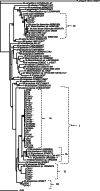Phylogeography and Symbiotic Effectiveness of Rhizobia Nodulating Chickpea (Cicer arietinum L.) in Ethiopia
- PMID: 33098438
- PMCID: PMC7982387
- DOI: 10.1007/s00248-020-01620-8
Phylogeography and Symbiotic Effectiveness of Rhizobia Nodulating Chickpea (Cicer arietinum L.) in Ethiopia
Abstract
Chickpea (Cicer arietinum L.) used to be considered a restrictive host that nodulated and fixed nitrogen only with Mesorhizobium ciceri and M. mediterraneum. Recent analysis revealed that chickpea can also establish effective symbioses with strains of several other Mesorhizobium species such as M. loti, M. haukuii, M. amorphae, M. muleiense, etc. These strains vary in their nitrogen fixation potential inviting further exploration. We characterized newly collected mesorhizobial strains isolated from various locations in Ethiopia to evaluate genetic diversity, biogeographic structure and symbiotic effectiveness. Symbiotic effectiveness was evaluated in Leonard Jars using a locally released chickpea cultivar "Nattoli". Most of the new isolates belonged to a clade related to M. plurifarium, with very few sequence differences, while the total collection of strains contained three additional mesorhizobial genospecies associated with M. ciceri, M. abyssinicae and an unidentified Mesorhizobium species isolated from a wild host in Eritrea. The four genospecies identified represented a subset of the eight major Mesorhizobium clades recently reported for Ethiopia based on metagenomic data. All Ethiopian strains had nearly identical symbiotic genes that grouped them in a single cluster with M. ciceri, M. mediterraneum and M. muleiense, but not with M. plurifarium. Some phylogeographic structure was observed, with elevation and geography explaining some of the genetic differences among strains, but the relation between genetic identity and symbiotic effectiveness was observed to be weak.
Keywords: Genetic diversity; Genospecies; Haplotypes; Mesorhizobial strains; Nucleotides; Spatial patterns.
Figures






Similar articles
-
Genetic and phenotypic diversity of rhizobia nodulating chickpea (Cicer arietinum L.) in soils from southern and central Ethiopia.Can J Microbiol. 2017 Aug;63(8):690-707. doi: 10.1139/cjm-2016-0776. Epub 2017 May 12. Can J Microbiol. 2017. PMID: 28499096
-
Rhizobium leguminosarum symbiovar trifolii, Ensifer numidicus and Mesorhizobium amorphae symbiovar ciceri (or Mesorhizobium loti) are new endosymbiotic bacteria of Lens culinaris Medik.FEMS Microbiol Ecol. 2016 Aug;92(8):fiw118. doi: 10.1093/femsec/fiw118. Epub 2016 Jun 5. FEMS Microbiol Ecol. 2016. PMID: 27267929
-
Genomic diversity and distribution of Mesorhizobium nodulating chickpea (Cicer arietinum L.) from low pH soils of Ethiopia.Syst Appl Microbiol. 2022 Jan;45(1):126279. doi: 10.1016/j.syapm.2021.126279. Epub 2021 Nov 16. Syst Appl Microbiol. 2022. PMID: 34839036
-
Core and symbiotic genes reveal nine Mesorhizobium genospecies and three symbiotic lineages among the rhizobia nodulating Cicer canariense in its natural habitat (La Palma, Canary Islands).Syst Appl Microbiol. 2014 Mar;37(2):140-8. doi: 10.1016/j.syapm.2013.08.004. Epub 2013 Oct 31. Syst Appl Microbiol. 2014. PMID: 24183896
-
Chickpea: Its Origin, Distribution, Nutrition, Benefits, Breeding, and Symbiotic Relationship with Mesorhizobium Species.Plants (Basel). 2024 Feb 1;13(3):429. doi: 10.3390/plants13030429. Plants (Basel). 2024. PMID: 38337962 Free PMC article. Review.
Cited by
-
Population and genetic diversity of rhizobia nodulating chickpea in Indo-Gangetic plains of India.Braz J Microbiol. 2024 Dec;55(4):4057-4075. doi: 10.1007/s42770-024-01473-0. Epub 2024 Aug 7. Braz J Microbiol. 2024. PMID: 39110399 Free PMC article.
References
-
- Purushothaman R, Upadhyaya HD, Gaur PM, Gowda CLL, Krishnamurthy L. Kabuli and desi chickpeas differ in their requirement for reproductive duration. Field Crop Res. 2014;163:24–31. doi: 10.1016/j.fcr.2014.04.006. - DOI
-
- Shiferaw B, Asfaw S, Abate B, et al. Current situation and future outlooks of the chickpea sub-sector in Ethiopia. Nairobi: ICRISAT and EIAR; 2009.
-
- Keneni G, Bekele E, Imtiaz M, Dagne K, Getu E, Assefa F. Genetic diversity and population structure of Ethiopian chickpea (Cicer arietinum L.) germplasm accessions from different geographical origins as revealed by microsatellite markers. Plant Mol Biol Report. 2012;30:654–665. doi: 10.1007/s11105-011-0374-6. - DOI
-
- Keneni G, Bekele E, Imtiaz M, Getu E, Dagne K, Assefa F. Breeding chickpea (Cicer arietinum [Fabaceae]) for better seed quality inadvertently increased susceptibility to adzuki bean beetle (Callosobruchus chinensis [Coleoptera: Bruchidae]) Int J Trop Insect Sci. 2011;31:249–261. doi: 10.1017/S1742758411000373. - DOI
MeSH terms
Substances
Supplementary concepts
LinkOut - more resources
Full Text Sources

